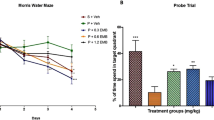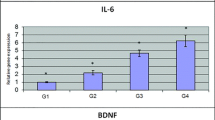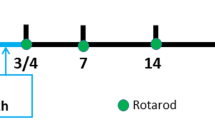Summary
Our previous studies showed that the nootropic drug Cerebrolysin®, applied immediately after the traumatic or excitotoxic brain lesion influenced spatial learning and memory. Long-lasting ameliorative effect of Cerebrolysin was found after its 4-week-administration, while two-week-treatment had only temporal effect.
With the aim to verify the capability of Cerebrolysin® to restore chronically deteriorated learning and memory, The drug was applied 4 months after lesioning the rat’s CNS. The present study shows that Cerebrolysin restored learning capability of the lesioned rats. Although their spatial memory was improved in comparison to lesion untreated controls, it did not reach the level of intact controls. The effect was more pronounced after the application of 1.25 ml/kg b. w. of Cerebrolysin® than after the application of 2.5 ml/kg b. w.
Access this chapter
Tax calculation will be finalised at checkout
Purchases are for personal use only
Preview
Unable to display preview. Download preview PDF.
Similar content being viewed by others
References
Akai F, Hiruma S, Sato T, Iwamoto N, Fujimoto M, Ioku M, Hashimoto S (1992) Neurotrophic factor like effect of FPF1070 on septal cholinergic neurons after transection of fimbria-fornix in the rat brain. Histol Histopathol 7: 213–221
Albrecht E, Hingel S, Crailsheim K, Windisch M (1993) The effects of Cerebrolysin on the vitality and sprouting of the neurons from hemispheres and from the brain stem of chicken embryos in vitro. In: Nicolini M, Zatta BF, Coriane B (eds) Alzheimer disease and related disorders. Pergamon Press, Oxford, pp 341–342
Barolin GS, Koppi S, Kappeller E (1996) Old and new aspects of stroke treatment with emphasis on metabolically active medication and rehabilitation outcome. EuroRehab 3: 135–143
Cunningham TJ, Sutilla CB, Haun F (1987) Trophic effect of transplants following damage to the cerebral cortex. Ann NY Acad Sci 495: 153–168
Dunnett SB (1990) Neural transplantation in animal models of dementia. Eur J Neurosci 2: 567–587
Francis-Turner L, Valoušková V (1996) Nerve growth factor and nootropic drug Cerebrolysin but not fibroblast growth factor can reduce spatial memory impairment elicited by fimbria-fornix transection: short-term study. Neurosci Lett 202: 193–196
Francis-Turner L, Valoušková V, Mokry J (1996) The long-term effect of NGF, b-FGF and Cerebrolysin on the spatial memory after fimbria-fornix lesion in rats. J Neural Transm 47: 277
Gschanes A, Valoušková V, Windisch M (1997) Ameliorative influence of a nootropic drug on motor activity of rats after bilateral carotid artery occlusion. J Neural Transm 104: 1319–1327
Olson L (1993) Reparative strategies in the brain: treatment strategies based on trophic factors and cell transfer techniques. Acta Neurochir [Suppl] 58: 3–7
Ruther E, Ritter R, Apecechea M, Freytag S, Windisch M (1994) Efficacy of peptidergic nootropic drug Cerebrolysin in patients with senile dementia of the Alzheimer type (SDAT). Pharmacopsychiatry 27: 32–40
Shimazu S, Iwamoto N, Itoh P, Akasako A, Seki H, Fujimoto M (1991) Neurotrophic activity of Cerebrolysin. In: Advantage in Alzheimer therapy, 2nd symposium, Springfield, p 51
Schwab M, Bauer R, Zwiener U (1997) Physiological effects and brain protection by hypothermia and Cerebrolysin after moderate forebrain ischemia in rats. Exp Toxic Pathol 49: 105–116
Valoušková V, Francis-Turner L (1996) b-FGF, NGF and Cerebrolysin ameliorate spatial memory impaired by lesion of substantia innominata. Eur J Neurosci [Suppl] 9: 146
Valoušková V, Gschanes A (1997) An effect of NGF, b-FGF and nootropic drug Cerebrolysin on spatial memory and on motor activity of rats: short-and long-term study. Neurobiol Learning Memory (in press)
Author information
Authors and Affiliations
Editor information
Editors and Affiliations
Rights and permissions
Copyright information
© 1998 Springer-Verlag Wien
About this paper
Cite this paper
Valoušková, V., Francis-Turner, L. (1998). Can Cerebrolysin® influence chronic deterioration of spatial learning and memory?. In: Jellinger, K., Fazekas, F., Windisch, M. (eds) Ageing and Dementia. Journal of Neural Transmission. Supplementa, vol 53. Springer, Vienna. https://doi.org/10.1007/978-3-7091-6467-9_30
Download citation
DOI: https://doi.org/10.1007/978-3-7091-6467-9_30
Publisher Name: Springer, Vienna
Print ISBN: 978-3-211-83114-4
Online ISBN: 978-3-7091-6467-9
eBook Packages: Springer Book Archive




